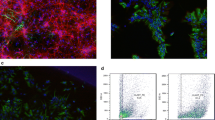Abstract
The adrenergic and serotonergic stimulations of rat C6 glioma cells have previously been shown to induce the activation of steroid 5α-reductase (5α-R) gene expression, resulting in their differentiation through the production of neuroactive 5α-reduced steroid metabolites. In addition, progesterone and histone deacetylase (HDAC) inhibitors have also been reported to promote the glial cell differentiation with the enhancement of serotonin-stimulated brain-derived neurotrophic factor gene transcription through the production of 5α-reduced neurosteroids, thus suggesting that glial cell differentiation is probably implicated in the protection and survival of neuronal cells in the brain. Therefore, the expression of 5α-R gene in glial cells seems physiologically important in maintaining the neural function in the brain, but little is known about the mechanism underlying the regulation of 5α-R gene transcription. In the present study, the effect of a HDAC inhibitor trichostatin A (TSA) on 5α-R gene transcription in the glioma cells was examined, and TSA was shown to induce the elevation of 5α-R mRNA levels through the activation of the 5α-R promoter via a mechanism involving Sp1 and Sp3 transcription factors in a time- and concentration-dependent manner. Thus, both Sp1 and Sp3 are considered to play a physiological role in the regulation of 5α-R gene expression, and hence the production of 5α-reduced neurosteroids in glial cells.







Similar content being viewed by others
References
Andrews, N. C., & Faller, D. V. (1991). A rapid micropreparation technique for extraction of DNA-binding proteins from limiting numbers of mammalian cells. Nucleic Acids Research, 19, 2499.
Boussif, O., Lezoualc’h, F., Zanta, M. A., Mergny, M. D., Scherman, D., Demeneix, B., et al. (1995). A versatile vector for gene and oligonucleotide transfer into cells in culture and in vivo: polyethylenimine. Proceedings of the National Academy of Sciences of the United States of America, 92, 7297–7301.
Choi, H. S., Lee, J. H., Park, J. G., & Lee, Y. I. (2002). Trichostatin A, a histone deacetylase inhibitor, activates the IGFBP-3 promoter by upregulating Sp1 activity in hepatoma cells: alteration of the Sp1/Sp3/HDAC1 multiprotein complex. Biochemical and Biophysical Research Communications, 296, 1005–1012.
Ghosh, A. K., Mori, Y., Dowling, E., & Varga, J. (2007). Trichostatin A blocks TGF-beta-induced collagen gene expression in skin fibroblasts: involvement of Sp1. Biochemical and Biophysical Research Communications, 354, 420–426.
Her, S., Bell, R. A., Bloom, A. K., Siddall, B. J., & Wong, D. L. (1999). Phenylethanolamine N-methyltransferase gene expression. Sp1 and MAZ potential for tissue-specific expression. Journal of Biological Chemistry, 274, 8698–8707.
Jaffe, R. C., Ferguson-Gottschall, S. D., Gao, W., Beam, C., & Fazleabas, A. T. (2007). Histone deacetylase inhibition and progesterone act synergistically to stimulate baboon glycodelin gene expression. Journal of Molecular Endocrinology, 38, 401–407.
Karssen, A. M., Li, J. Z., Her, S., Patel, P. D., Meng, F., Evans, S. J., et al. (2006). Application of microarray technology in primate behavioral neuroscience research. Methods, 38, 227–234.
Melcangi, R. C., Riva, M. A., Fumagalli, F., Magnaghi, V., Racagni, G., Martini, L., et al. (1996). Effect of progesterone, testosterone and their 5α-reduced metabolites on GFAP gene expression in type 1 astrocytes. Brain Research, 711, 10–15.
Morita, K., & Her, S. (2008). Progesterone pretreatment enhances serotonin-stimulated BDNF gene expression in rat C6 glioma cells through production of 5α-reduced neurosteroids. Journal of Molecular Neuroscience, 34, 193–200.
Morita, K., Arimochi, H., & Tsuruo, Y. (2004). Adrenergic activation of steroid 5α-reductase gene expression in rat C6 glioma cells: involvement of cyclic AMP/protein kinase A-mediated signaling pathway. Journal of Molecular Neuroscience, 22, 205–212.
Morita, K., Arimochi, H., & Her, S. (2005). Serotonergic 5-HT2A receptor stimulation induces steroid 5α-reductase gene expression in rat C6 glioma cells via transcription factor Egr-1. Brain Research. Molecular Brain Research, 139, 193–200.
Morita, K., Arimochi, H., Itoh, H., & Her, S. (2006). Possible involvement of 5α-reduced neurosteroids in adrenergic and serotonergic stimulation of GFAP gene expression in rat C6 glioma cells. Brain Research, 1085, 49–56.
Morita, K., Gotohda, T., Arimochi, H., Lee, M. S., & Her, S. (2009). Histone deacetylase inhibitors promote neurosteroid-mediated cell differentiation and enhance serotonin-stimulated brain-derived neurotrophic factor gene expression in rat C6 glioma cells. Journal of Neuroscience Research, 87, 2608–2614.
Schroeder, F. A., Lin, C. L., Crusio, W. E., & Akbarian, S. (2007). Antidepressant-like effects of the histone deacetylase inhibitor, sodium butyrate, in the mouse. Biological Psychiatry, 62, 55-64.
Taniura, S., Kamitani, H., Watanabe, T., & Eling, T. E. (2002). Transcriptional regulation of cyclooxygenase-1 by histone deacetylase inhibitors in normal human astrocyte cells. Journal of Biological Chemistry, 277, 16823–16830.
Walker, G. E., Wilson, E. M., Powell, D., & Oh, Y. (2001). Butyrate, a histone deacetylase inhibitor, activates the human IGF binding protein-3 promoter in breast cancer cells: molecular mechanism involves an Sp1/Sp3 multiprotein complex. Endocrinology, 142, 3817–3827.
Zeissig, S., Fromm, A., Mankertz, J., Weiske, J., Zeitz, M., Fromm, M., et al. (2007). Butyrate induces intestinal sodium absorption via Sp3-mediated transcriptional up-regulation of epithelial sodium channels. Gastroenterology, 132, 236–248.
Acknowledgment
This work was supported by a grant of the Korean Basic Science Institute (T29740).
Author information
Authors and Affiliations
Corresponding author
Rights and permissions
About this article
Cite this article
Her, S., Lee, MS. & Morita, K. Trichostatin A Stimulates Steroid 5α-Reductase Gene Expression in Rat C6 Glioma Cells via a Mechanism Involving Sp1 and Sp3 Transcription Factors. J Mol Neurosci 41, 252–262 (2010). https://doi.org/10.1007/s12031-009-9284-6
Received:
Accepted:
Published:
Issue Date:
DOI: https://doi.org/10.1007/s12031-009-9284-6




